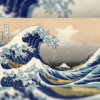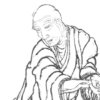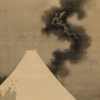Kanō Masanobu
| NAME | Kanō Masanobu / 狩野正信 |
| BIRTH & DEATH | 1434-1530 |
| BIRTHPLACE | Shizuoka pref. |
| PEN NAME | 祐清, 祐勢, 祐盛 |
| MASTER | Tenshō Shūbun, Oguri Sōtan |
| POSITION |
|
| RECORD OF AWARDS |
|
| NOTE |
DESCRIPTION
Kanō Masanobu (狩野正信, 1434-1530) was a Japanese-style painter of the Muromachi period and the founder of the Kanō school.
The Kanō school remained active for over 400 years from the Muromachi period till the Meiji period, and it was always the center of the Japanese painting world. The founder of this Kanō school is said to be Kanō Masanobu, who was the official painter of the Muromachi bakufu (Japanese feudal government headed by a Shogun). From old records, it is clear that Masanobu was a painter at Kyō in 1463, and by then he was thought to be already an official painter in the Shogun’s court. He is said to have died in 1530, which would mean he was 97 years old.
There is a tradition that Masanobu was a descendant of Kanō Munemochi from Izu Province to Kyoto to serve the shogun Ashikaga Yoshimasa. Studied under Shūbun and Oguri Sōtan, whom he succeeded as official painter to the shogun. In 1483, he was in charge of the partition wall paintings of the Higashiyama mountain retreat built by Ashikaga Yoshimasa.
“Shū Moshuku Airen-zu” (Zhou Maoshu Appreciating Lotuses), which was based on a Chinese historical event, is said to be his best known work amongst those that still exist. Historically, other famous works include “Sansui-zu” (Landscape) at the Kyūshū National Museum, and “Gaika-Hotei-zu,” which is privately owned. The Daitoku-ji temple Shinju-an’s “Chikuseki-Hakkaku-zu” (bamboo, stone and crane) (Six-paneled folding screens) is also traditionally said to be Masanobu’s work, even though no signature stamps exist.
Judging from existing works, many of his pieces were done in the Kanga style (Chinese style painting, as opposed to the colorful Yamato-e Japanese style paintings) using the Suiboku ink-wash method. However, amongst them, “Shū Moshuku Airen-zu” is a plain picture, which has a large blank space at the top, and the green color of the big willow tree in the foreground is impressive. There are also some Buddhist paintings such as “Monju-Bosatsu-zu” (Manjusri Bodhisattva) (The Museum of Modern Art, Gunma), and he is thought to have painted different subjects and different styles as an occupational painter.










